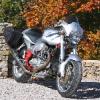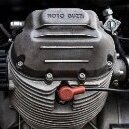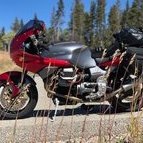Leaderboard
Popular Content
Showing content with the highest reputation on 05/09/2022 in all areas
-
@p6x Metal core timing cover gasket: https://www.mgcycle.com/index.php?main_page=product_info&products_id=5044:996740de914ced0902e686373e3193914 points
-
The MG cycle gasket is better than the valpolini in my opinion. It's a Guzzi part as well. Ciao2 points
-
Use of course the later coated metal gasket to replace it and cure the issue permanently. Ciao2 points
-
Getting closer. I presume the entire top of the motor is completely dry (?) There are other culprits, otherwise. The O-rings of the oil cooler lines and the timing chest gasket. Also, I see a "P.Roper Plate" installed. The three gaskets of the plate/sump spacer/sump are also suspect. Once you have it all cleaned, again, spray the surfaces with a commonly available dry foot powder. Start up, idle/rev, and look for discoloration. If none, then ride around the block at low speed (low wind to blow the oil away from the source). Look for discoloration of the powder. It will be the leak source.2 points
-
Hi, Marco! So, first, screw in the left side idle stop screw until it bumps the linkage slightly open (you'll come back to that in the last step to set the final idle). Start the motor an use the twist grip to bring the rpm up to 2000-3000, then use the white knob to equalize the vacuum on the balancing tool. Some of these balancing tools have a "sensitivity" setting and some use restrictors to connect to the vacuum ports on the intakes. (It is connected to the intakes just ahead of the throttle bodies?)2 points
-
Hello all !! 2002 Le Mans , followed the instructions found here for a decent tune up. valve adjustment, tps setting etc etc. I am using a motion pro tool to balance the throttle bodies but I don’t see the blue fluid raising in the tool columns. as per instructions I have screwed all the way in the air bypass screw and backed them out one full turn . the left and right side idle set screw are backed out. I used the square white knob to somewhat let the engine idle. if I play around with the air bypass screw nothing shows up on the tool. Sometimes this happens to my carbureted Guzzi and I am always able to play with the carb until some fluid start showing up in the column of the tool. this time not and since it’s the first time I am balancing throttle bodies… maybe I missed something? any help highly appreciated. ciao marco1 point
-
Touche doc. I'd tend to agree, but no obvious signs of hydraulic issues up above, and i'd have thought i'd see other signs of damaged paint leading to that area. But now that you mention it, worth a re-look.1 point
-
1 point
-
I did not know they are different. Thanks for the clarification! @p6x asked, "Can this timing chest/case can be removed without taking the engine down completely? " The answer is, "yes." Other things have to get out of the way. Someone did this recently and posted. Maybe @andy york or @Pressureangle in one of the Timing Gears threads . . .1 point
-
I'll state my understanding here without citation of sources, which I've either buried or failed to save. ZDDP works by attaching ionic molecules to the base metal, creating a boundary layer of ZDDP which is far more durable and scuff-resistant than the base metal. ZDDP is bad for the lifespan of catalytic converters, so they first limited the amount added, then by the SG oil classification eliminated it almost entirely. My recent research into gear oils and greases led also to the knowledge that Boron/Moly compounds are replacing ZDDP as extreme pressure additives, but they work with a different chemical strategy-I'm not sure if they stack up in pores, or attach chemically, but they are an order of magnitude more slippery than ZDDP when in place and apparently do less harm to cats. Don't have meaningful information at hand, but I don't think 'overplating' is an issue as much as the 'minimum required amount' of ZDDP. An old automotive V8 has a lot more surfaces to cover than a V2, and generally holds less oil per surface inch. Meh, the ZDDP content per quart is probably the 'minumim required' balanced with 'least material cost'.1 point
-
Here it is! I used baby powder, the one you put on the parts that go inside the diaper, to prevent a rash. So the leak comes from that gasket between the engine and the timing chest/case that seemed suspicious yesterday. Can this timing chest/case can be removed without taking the engine down completely? @Lucky Philwhere should I order the "coated metal gasket"?1 point
-
Yes it did Running like a champ. IDK how it ran ok for a few weeks when I first got it, but the lines were connected wrong by previous owner and I didn't have enough knowledge at time to see the problem right before my eyes.1 point
-
I'm betting on the timing chest gasket, although they usually blow out further up.1 point
-
The timing chest gasket is a known weakpoint in the V11. Does your V11 have a support bracket/plate between the gearbox and the engine, connected to the frame? Should be between the throttle bodies. I can see she does have two connecting arms running from the sideplates/porkchops to the lower back of the engine (photo 3), so the other bracket should also be there. These remove some of the stress on the timing chest (thus gasket), but a leak can still occur there.1 point
-
Photo #1 This oil droplet does not mean the leak comes from the filter access trap. This is the lowest point on the bike, so whatever oil seeps, it collects there. Correct? Photo#2 The right side of the engine is oil wet, with no obvious source. It is like a coat. I presume it is a small seepage. Photo#3 Whatever happens, it coats all the fins on the right hand side and underneath the engine. Photo#4 I cleaned the engine as best as I could, with water and an industrial de-greaser. After a return trip to Beaumont, here's the verdict. The bottom of the sump seems to be dry, but close to that hole, this is wet. Photo 5 This is where I think the seepage is occurring. It is difficult to tell. But it would explain why the right hand side only. Photo#6 The left hose connection is dry. Sorry the photo is a bit unfocused, I was using a slow speed. Photo#7 The right hose connection is dry. Photo #8 You can see the beginning of a droplet forming underneath the oil filter access. The fins right after are also dirty. Need to clean them better next time.1 point
-
Yeah, I would not wind on the white knob anymore until the balance tool is set up. There is a mechanical method to pre-set the balance at idle. I think @gstallons posted this procedure. Might be a way to get your throttle rod back close to balance before the Balance Tool can be used . . .1 point
-
1 point
-
Mine is the white and blue with 4 columns. i have a picture but it’s too large to be posted . It’s sold for about 100 bucks or the usual websites. I will try to play with it . thank your again.1 point
-
With fuel prices up lately in the USA, someone mentioned my bike thinking it makes impressive fuel economy. I had to admit that it is almost double that of my passenger cars, yet . . . The commute to my office in the passenger cars is 9 miles/ 15km. On the V11 Sport, the commute is 50 miles/80 km.1 point
-
Indeed, @thelonewonderer's V11 is in the range of those that benefit from the added 6th Kiwi_Roy Relay to relieve the burden on the Ignition Switch. The battery actually can be load tested on the bike: Key off - an AGM battery is 100% at 12.84v and 50% at ~12.50v. Key on /lights on - Good if the voltage stays above 12.0, but okay even above ~11.8. Engage the starter (in your case only the solenoid) and look for values above 10v.1 point
-
1 point








